|
When we entertain, whether cocktails or dinner, we serve drinks and hors d’oeuvre with as little effort as possible.
If we’re going to serve wine, we start with open bottles of red and white, and leave unopened bottles on the side so guests can uncork them when they’re ready for more.
If we’re serving cocktails, we mix pitchers of Margaritas or Bloody Marys in advance, and leave fix-your-own ingredients on the side for the Martini crowd, gin-and-tonic and whiskey-and-soda fanciers.
For nibbles, we create a charcuterie board. There is no preparation required, with the possible exception of slicing a baguette.
Just purchase the ingredients and place them on a cheese board or tray and arrange them in an attractive manner.
National Charcuterie Board Day is August 26th, but check out the year’s 75 meat holidays.
> The history of charcuterie.
> The different types of charcuterie: a photo glossary.
> Wine pairings for charcuterie.
WHAT IS CHARCUTERIE?
Charcuterie (shar-KOO-tuh-REE) is a French term for fancy pork-based and related products made by a charcutier (shar-koo-tee-AIR), a specially trained pork butcher.
Originally, the art of charcuterie was used to preserve meat in the Middle Ages. The art continues in France as a hallmark of fine cuisine.
While many charcuterie products contain only pork as their meat base, just as often the pork is combined with other meats, fowl or game.
Modern charcuterie has expanded to include items with no pork at all—products made only of poultry, venison, vegetables or fish.
Check out our Charcuterie Glossary for the products are common offerings of a charcutier.
WHAT’S ON A CHARCUTERIE BOARD (PLATE)?
It’s not just meat. You can often order meat-only charcuterie plates at restaurants.
But many charcuterie plates—especially those served at cocktail parties or before dinner—contain cheeses and garnishes.
Thus, it’s not just cured meats and pâtés, but:
Artisan breads and toasts
Assorted fine cheeses (semihard, soft, blue, etc.)
Assorted olives
Dried fruits
Fresh fruits: grapes plus small varieties like clementines, kumquats and Lady apples and figs
Mustard and fig or sour cherry jam
Pickled vegetables: artichoke hearts, dilly beans, cornichons, peppadews, sweet gherkins
Pickled fruits, especially those that are easy to pick up, like apple and pear slices
Here’s how to quick-pickle fruits and vegetables.
RULES OF THUMB
Go for bold colors and flavors that provide a special experience (people can eat ham and Swiss at home).
Fresh vegetables brighten up a board, including grape tomatoes, baby carrots and radishes.
Dried fruits brighten up a board: apricots plus tropical dried fruits like kiwi, mango and papaya (although dates and figs are wonderful with charcuterie.
For fresh fruits, go for color: some raspberries and/or strawberries, multicolored seedless grapes, orange slices.
Mix the classic and the new items, the sweet and the salty, a contrast of textures.
To help with your own selection, consider cheeses, meats and condiments from a specific region or country’s cuisine. American, French and Italian are popular, but how about Greek or Scandinavian?
Offer enough variety for the different preferences.
For vegans, provide more fruit options, plus raw vegetables. If your cheese counter sells vegan cheese, pick one up. Vegan cheeses like Miyoko’s are delicious.
Arrange items with enough space between them. If things are too crowded, it impedes making a choice.
If you find that you have too much for one board, set up a second board. Put it on a separate surface, if feasible.
Don’t worry about buying too much. You can enjoy the leftovers for breakfast, lunch and dinner, with soups and salads, until they’re gone.
TIP: We often melt the leftover cheeses into a fondue, dipping leftover bread, dried fruits and charcuterie!
HOW MUCH SHOULD YOU CHOOSE?
For A Small Group
Here’s a suggestion from DeLallo, an online purveyor of fine foods, who contributed much of the content for this article.
For 4 to 8 guests:
4-5 cheeses
3-4 meats (prosciutto, salami, sausage)
3-4 olive and antipasto items
1-2 spreads
2 crackers/breads/breadsticks
Dried fruits and nuts
Fresh items to accent the board: herbs, small fruits (mandarins, grapes), raw vegetables
Here’s what DeLallo chose for the smaller charcuterie board.
For 8 Or More
For a larger crowd, consider:
5-6 cheeses
4-5 meats
7-8 olive and antipasto items
2-3 spread
5-6 starches (breads, breadsticks, crackers, gourmet toasts)
Fresh items to accent (herbs, fruit, veggies)
Dried fruit and nuts
Fresh items to accent the board: herbs, small fruits (mandarins, grapes), raw vegetables
> Here’s what DeLallo chose for the charcuterie board.
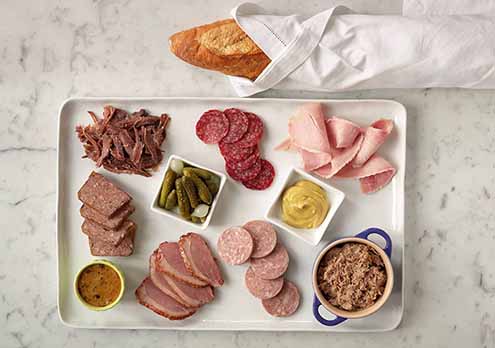
[8] No board needed: use a tray (photo © Les Trois Petits Cochons).
|
|
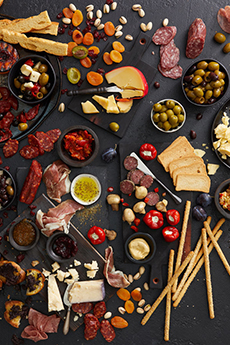
[1] A slate board creates a dramatic backdrop for the charcuterie and cheeses (photos #1, #2 and #3 © DeLallo).

[2] A white tray or board brightens up the goodies. You can place a small plate atop the board to hold soft cheeses or pâtéa, so they don’t “spread” onto other items.
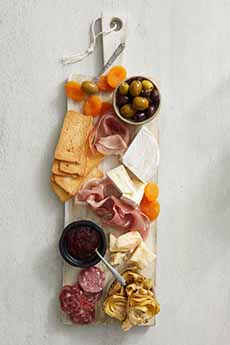
[3] A smaller board for two to four nibblers.
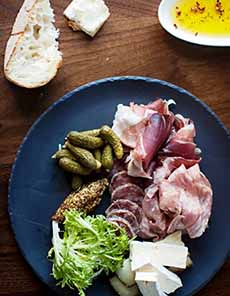
[4] You don’t need a board, just a plate (photo © Conrad New York | Hilton).

[5] Cornichons are savory pickles. Sweet gherkins are another option (photo © The Nibble).
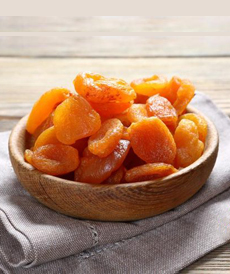
[6] Dried apricots are delicious with charcuterie, and add color to the board (photo © Olha Afanasieva | iStock Photo.
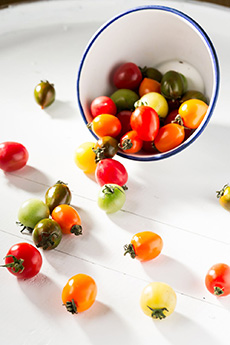
[7] Multicolored grape tomatoes are a festive garnish (photo © Lovefood Art | Pexels).
|










